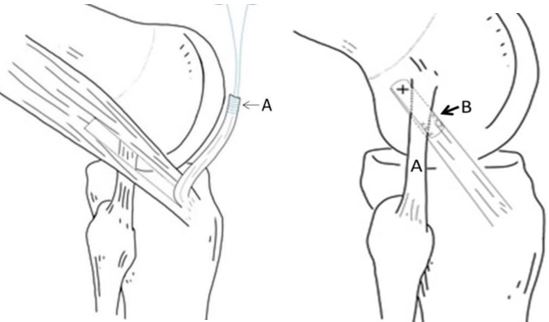Lateral Extra articular Tenodesis (L.E.T.) to control Anterolateral instability associated with ACL (Anterior cruciate ligament) deficient knees– A Novel study
Abstract
Introduction: Chronic ACL laxity, in particular Rotational laxity associated with an explosive pivot shift test, has being tend to cause combined damage to ACL and Anterolateral structures of knee. We, hereby present a study of adding a LET procedure to such Anterolateral Rotational instability.
Material and methods: We operated 8 cases (All males) with complete ACL tear with Anterolateral instability (7 patients with Grade 2 Pivot shift test,1 with Chronic ACL injury) from May 2020 to October 2021.We did primary ACL reconstruction in all knees, with adding LET procedure (Modified Lemaire’s technique).
Results: All patients were followed up for period of 6 months to 1 year (Average 8.6 months). A pre & Postoperative outcome scores were assessed by Lachman test, Pivot shift test (-ve in all, in post-op follow-up), Lysholm score (mean 90.75, %,) and Tegner score (average Gr 4).
Conclusion: After this study we can conclude that adding a LET procedure (Modified Lemaire’s technique) to an ACL deficient knee with Anterolateral instability (like explosive Pivot shift test), is beneficial as not only it reduces the Anterolateral instability but also, greatly reduces the risk of Graft Failure.
Downloads
References
2) Lemaire M. Chronic knee instability Technics and result of ligament plasty in sports injuries. J Chir. 1975; 110: 281-294.
3).Macintosh D. Lateral substitution Reconstruction. In proceedings of Canadian Orthopaedic Association. J Bone Joint Surg. 1976; 58: 142
4) Loose RE, Johnson TR, Southwick W. Anterior subluxation of lateral tibial plateau. A diagnostic test and operative repair. J Bone Joint Surg Am. 1978 ; 60: 1015 – 1030
5) Arnold J, Cocker T, Heaton L, et al. Natural history of anterior cruciate tears. Am J Sports Med. 1979; 305 - 313.
6) Marcacci M, Zaffagnini S, Giordano G, et al. Anterior cruciate ligament reconstruction associated with extra-articular tenodesis :A prospective clinical and radiographic evaluation with 10 - to 13- year follow- up. Am J Sports Med. 2009; 37: 707-714.
7) Tegner Y, Lysholm J. Rating systems in the evaluation of the knee ligament injuries. Clin Orthop 1985 ; 198: 43-9.
8)Claes S. Vereecke E, Maes M, Victor J, Verdonk P, Bellmans J. Anatomy of anterolateral ligament of Knee. J Anat. 2013; 223:321 - 328.
9) Bonasia DE, D' Amelio A, Pellergrino P, Rosso F, Rossi R. Anterolateral Ligament of the knee :Back to the future in Anterior cruciate ligament reconstruction. Orthop Rev (Pavia) 2015 ;7:5773.
10) Edoardo Monaco et al. Extra articular ACL Reconstruction and pivot shift :In Vivo Dyanamic Evaluation with Navigation. Am J Sports Med. 2014 july.
11) Dominique Saragagila, Alexis Pison and Ramase Refaie. Lateral tenodesis combined with ACL Reconstruction using a unique semitendinous and gracilis transplant. Int Orthop 2013 Aug ;37 (8):1575 - 1581.
12) Sonnery-Cottet B, Claes S, Blackeney WG et. al. Scientific Anterior cruciate ligament Network International (SANTI) study group. Anterolateral ligament : let's stick to the facts! Arthoscopy 2018 ;34: 2262 - 2266.
13) Ra HJ, Kim JH, Lee DH. comparative clinical outcome anterolateral ligament reconstruction versus lateral articular tenodesis in combination with Anterior cruciate ligament reconstruction :systematic review and meta - analysis. Arch Orthop Trauma Surg. doi :10. 1007/s00402-020-03393-8.
14) Romy Deviandri et al. Isolated lateral extra - articular tenodesis enhance better rotatory knee joint stability, post primary ACL repair: four cases report and literature review. Int J Surge Case Rep. 2021 Jul.
15) Patel KA, Chhabra A, Goodwin JA, Hartigan DE. Identification of the Anterolateral Ligament on Magnetic Resonance Imaging. Arthrosc Tech. 2017;6:e137–e141.


This work is licensed under a Creative Commons Attribution-NonCommercial 4.0 International License.
The entire contents of the Orthopaedic Journal of Madhya Pradesh Chapter are protected under Indian and International copyrights. Orthopaedic Journal of Madhya Pradesh Chapter allow authors to retain the copyrights of their papers without restrictions, Authors grant the publisher the right of exclusive publication. The Journal then grants to all users a free, irrevocable, worldwide, perpetual right of access to, and a license to copy, use, distribute, perform and display the work publicly and to make and distribute derivative works in any digital medium for any reasonable non-commercial purpose, subject to proper attribution of authorship. The journal also grants the right to make numbers of printed copies for their personal non-commercial use under Creative Commons Attribution-Non-commercial share alike 4.0 International Public License.

 OAI - Open Archives Initiative
OAI - Open Archives Initiative












